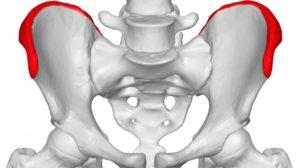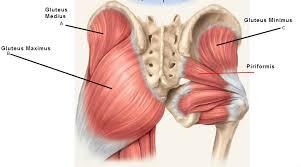The pain is constant and getting worse. You are getting worried that you may have a serious hip problem or arthritis. What muscles are on the side of your hip? What are the causes of outer hip pain? What can I do for outer hip pain? Are there regenerative options? Let’s dig in.
Understanding Hip Basics

Highlighted in Red: Iliac Crest
The hip is a ball-socket joint. The ball is the top part of the thigh bone (femur). The socket is formed by the ilium bone which is one of three bones that make up the pelvis. The ball-socket joint moves in different directions and is lined with cartilage. The actual hip joint is located approximately at the crease between your stomach and top of your thigh. This area is also known as the groin. The top of the ilium bone is called the iliac crest (waist bone). If you firmly place your hand on your waist you can feel a bone that spans your side. This is your iliac crest. This is illustrated in the image to the right.

Femur Bone: Greater Trochanter
The femur bone spans from the ball portion of the hip down to the knee. On the side of the femur is a boney knob that is called the greater trochanter. This is important as this is where many muscles attach. If you are standing and put the arms to your sides you can feel a boney knob on the side of your thigh. This is your greater trochanter.
What Muscles Are on the Side of Your Hip?
Tendons are thick pieces of connective tissue that enable a muscle to attach to the bone. There are many important muscles that attach to the top of the waist bone. These include:
Tensor Fasciae Latae: A thin yet powerful muscle that stabilizes the hip, extends the hip and along with the gluteus maximus forms the iliotibial band. (1)

Internal and External Obliques: Important abdominal muscles that assist with respiration and produce trunk rotation and side-bending.
Latissimus Dorsi: A large, triangular muscle in the back that is important in the flexion, extension of the trunk, and various shoulder movements (2).
Are There Other Muscles On the Side of Your Hip?
Yes. Immediately below the top of the waist bone are the powerful and important gluteal muscles. The most important muscles are the Gluteus maximus, medius, and minimus. They travel down the hip bone and attach to greater trochanter. These muscles attach via tendons which are thick bands of connective tissue. The tendons are susceptible to degeneration, injury, inflammation, and tears. As such these tendons are possible sources of the side of hip pain.
What Are the Causes of Outer Hip Pain?
There are many different causes of outer hip pain. I have categorized them into two groups: Direct and Referred. Direct causes are those directly related to the hip bone itself and the structures that attach to it. Referred pain is pain that is felt or perceived in a part of the body other than its actual source.
Direct Causes of Outer Hip Pain Include:
Hip Fracture (4)
Cancer
Tendonitis: Inflammation, degeneration, or tearing of any of the muscles or tendons that attach to the ilium.
Bursitis: A bursa is a fluid-filled sac that enables muscles, tendons, and ligaments to glide smoothly over boney surfaces. The bursae can become inflamed and cause outer hip pain. This is oftentimes referred to as trochanteric bursitis by your doctor.
Ligament injury: Many ligaments attach to the hip and provide important support. The iliolumbar ligament for example attaches to the iliac crest and is critical to the stability of the sacroiliac joint (3). These ligaments can be injured, stretched, or torn.
Pregnancy and childbirth (5)
Referred Sources of Outer Hip Pain Include:
Sacroiliac joint injury
Lumbar disc injury: disc protrusions, herniations, and bulges can cause outer hip pain (6)
What Can I Do for Outer Hip Pain?
For the best results, one needs to identify and treat the underlying problem or source of the pain. Physical examination is critical and often times can help identify the underlying problem or problems. An X-ray can identify fractures or cancer lesions in the bone. In-office ultrasound is useful to evaluate these structures and avoids a trip to the MRI center and possible viral exposure. The Physicians at the Centeno-Schultz Clinic are experts in the treatment of outer hip pain and the diagnosis of muscle, tendon, and ligament injuries. Treatment options include PRP and stem cells which can accelerate healing (7). To learn more about outer hip pain please click on the video below.

In Conclusion
The hip is a ball-socket joint. The ball is on the top part of the thigh bone which is called the femur. The socket is formed by the ilium bone. The hip joint is actually located in the groin area. Many of us have pain on the outer hip. Muscles and tendons attach to both the iliac crest and the greater trochanter. These muscles include tensor fascia lata, internal and external obliques, gluteus maximus, minimus, and medius. These muscles and tendons can become injured, degenerated or torn, and become the source of outer hip pain. There are two major causes of outer hip pain which include direct and referred. The best treatment for outer hip pain requires the identification and treatment of the underlying problem or source of pain. Often times the outer hip pain does not involve the hip joint itself.
If you spend more time on the foam roller than you do working out we have treatment options to help you. The Physicians at the Centeno-Schultz Clinic are experts in the diagnosis and management of outer hip pain. Schedule a Telemedicine consultation from the comfort of your home or cabin. Talk with a board-certified, fellowship-trained physician about regenerative treatment options which may include PRP or stem cells. Don’t let this pain hijack your life and your joy. Schedule now and get back in the game.
1.Gottschalk F, Kourosh S, Leveau B. The functional anatomy of tensor fasciae latae and gluteus medius and minimus. J Anat. 1989;166:179-189.
2.Bhatt CR, Prajapati B, Patil DS, Patel VD, Singh BG, Mehta CD. Variation in the insertion of the latissimus dorsi & its clinical importance. J Orthop. 2013;10(1):25-28. Published 2013 Mar 7. doi:10.1016/j.jor.2013.01.002
3.Vleeming A, Schuenke MD, Masi AT, Carreiro JE, Danneels L, Willard FH. The sacroiliac joint: an overview of its anatomy, function and potential clinical implications. J Anat. 2012;221(6):537-567. doi:10.1111/j.1469-7580.2012.01564.x
4.MRI Appearance of Chronic Stress Injury of the Iliac Crest Apophysis in Adolescent Athletes. Kenneth J. Hébert, Tal Laor, Jon G. Divine, Kathleen H. Emery, and Eric J. Wall. American Journal of Roentgenology. 2008 190:6, 1487-1491
5.Verstraete EH, Vanderstraeten G, Parewijck W. Pelvic Girdle Pain during or after Pregnancy: a review of recent evidence and a clinical care path proposal. Facts Views Vis Obgyn. 2013;5(1):33-43.
6.Allegri M, Montella S, Salici F, et al. Mechanisms of low back pain: a guide for diagnosis and therapy. F1000Res. 2016;5:F1000 Faculty Rev-1530. Published 2016 Jun 28. doi:10.12688/f1000research.8105.2
7.Lee JJ, Harrison JR, Boachie-Adjei K, Vargas E, Moley PJ. Platelet-Rich Plasma Injections With Needle Tenotomy for Gluteus Medius Tendinopathy: A Registry Study With Prospective Follow-up. Orthop J Sports Med. 2016;4(11):2325967116671692. Published 2016 Nov 9. doi:10.1177/2325967116671692

